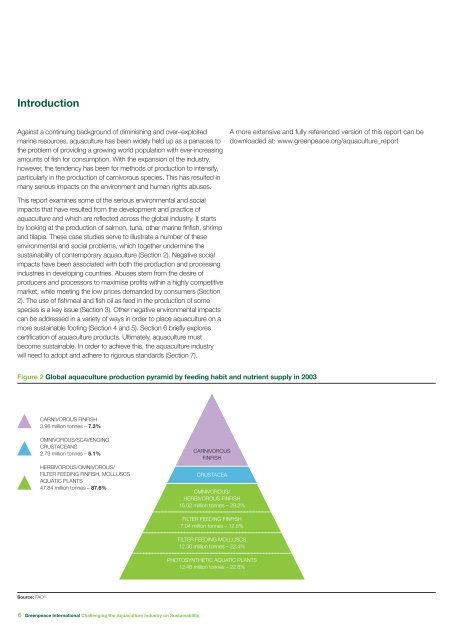Challenging the Aquaculture Industry on Sustainability-Greenpeace ...
Challenging the Aquaculture Industry on Sustainability-Greenpeace ...
Challenging the Aquaculture Industry on Sustainability-Greenpeace ...
You also want an ePaper? Increase the reach of your titles
YUMPU automatically turns print PDFs into web optimized ePapers that Google loves.
Introducti<strong>on</strong><br />
Against a c<strong>on</strong>tinuing background of diminishing and over–exploited<br />
marine resources, aquaculture has been widely held up as a panacea to<br />
<str<strong>on</strong>g>the</str<strong>on</strong>g> problem of providing a growing world populati<strong>on</strong> with ever-increasing<br />
amounts of fish for c<strong>on</strong>sumpti<strong>on</strong>. With <str<strong>on</strong>g>the</str<strong>on</strong>g> expansi<strong>on</strong> of <str<strong>on</strong>g>the</str<strong>on</strong>g> industry,<br />
however, <str<strong>on</strong>g>the</str<strong>on</strong>g> tendency has been for methods of producti<strong>on</strong> to intensify,<br />
particularly in <str<strong>on</strong>g>the</str<strong>on</strong>g> producti<strong>on</strong> of carnivorous species. This has resulted in<br />
many serious impacts <strong>on</strong> <str<strong>on</strong>g>the</str<strong>on</strong>g> envir<strong>on</strong>ment and human rights abuses.<br />
A more extensive and fully referenced versi<strong>on</strong> of this report can be<br />
downloaded at: www.greenpeace.org/aquaculture_report<br />
This report examines some of <str<strong>on</strong>g>the</str<strong>on</strong>g> serious envir<strong>on</strong>mental and social<br />
impacts that have resulted from <str<strong>on</strong>g>the</str<strong>on</strong>g> development and practice of<br />
aquaculture and which are reflected across <str<strong>on</strong>g>the</str<strong>on</strong>g> global industry. It starts<br />
by looking at <str<strong>on</strong>g>the</str<strong>on</strong>g> producti<strong>on</strong> of salm<strong>on</strong>, tuna, o<str<strong>on</strong>g>the</str<strong>on</strong>g>r marine finfish, shrimp<br />
and tilapia. These case studies serve to illustrate a number of <str<strong>on</strong>g>the</str<strong>on</strong>g>se<br />
envir<strong>on</strong>mental and social problems, which toge<str<strong>on</strong>g>the</str<strong>on</strong>g>r undermine <str<strong>on</strong>g>the</str<strong>on</strong>g><br />
sustainability of c<strong>on</strong>temporary aquaculture (Secti<strong>on</strong> 2). Negative social<br />
impacts have been associated with both <str<strong>on</strong>g>the</str<strong>on</strong>g> producti<strong>on</strong> and processing<br />
industries in developing countries. Abuses stem from <str<strong>on</strong>g>the</str<strong>on</strong>g> desire of<br />
producers and processors to maximise profits within a highly competitive<br />
market, while meeting <str<strong>on</strong>g>the</str<strong>on</strong>g> low prices demanded by c<strong>on</strong>sumers (Secti<strong>on</strong><br />
2). The use of fishmeal and fish oil as feed in <str<strong>on</strong>g>the</str<strong>on</strong>g> producti<strong>on</strong> of some<br />
species is a key issue (Secti<strong>on</strong> 3). O<str<strong>on</strong>g>the</str<strong>on</strong>g>r negative envir<strong>on</strong>mental impacts<br />
can be addressed in a variety of ways in order to place aquaculture <strong>on</strong> a<br />
more sustainable footing (Secti<strong>on</strong> 4 and 5). Secti<strong>on</strong> 6 briefly explores<br />
certificati<strong>on</strong> of aquaculture products. Ultimately, aquaculture must<br />
become sustainable. In order to achieve this, <str<strong>on</strong>g>the</str<strong>on</strong>g> aquaculture industry<br />
will need to adopt and adhere to rigorous standards (Secti<strong>on</strong> 7).<br />
Figure 2 Global aquaculture producti<strong>on</strong> pyramid by feeding habit and nutrient supply in 2003<br />
CARNIVOROUS FINFISH<br />
3.98 milli<strong>on</strong> t<strong>on</strong>nes – 7.3%<br />
OMNIVOROUS/SCAVENGING<br />
CRUSTACEANS<br />
2.79 milli<strong>on</strong> t<strong>on</strong>nes – 5.1%<br />
HERBIVOROUS/OMNIVOROUS/<br />
FILTER FEEDING FINFISH, MOLLUSCS<br />
AQUATIC PLANTS<br />
47.84 milli<strong>on</strong> t<strong>on</strong>nes – 87.6%<br />
CARNIVOROUS<br />
FINFISH<br />
CRUSTACEA<br />
OMNIVOROUS/<br />
HERBIVOROUS FINFISH<br />
16.02 milli<strong>on</strong> t<strong>on</strong>nes – 29.2%<br />
FILTER FEEDING FINFISH<br />
7.04 milli<strong>on</strong> t<strong>on</strong>nes – 12.8%<br />
FILTER FEEDING MOLLUSCS<br />
12.30 milli<strong>on</strong> t<strong>on</strong>nes – 22.4%<br />
PHOTOSYNTHETIC AQUATIC PLANTS<br />
12.48 milli<strong>on</strong> t<strong>on</strong>nes – 22.8%<br />
Source: FAO 52<br />
6 <strong>Greenpeace</strong> Internati<strong>on</strong>al <str<strong>on</strong>g>Challenging</str<strong>on</strong>g> <str<strong>on</strong>g>the</str<strong>on</strong>g> <str<strong>on</strong>g>Aquaculture</str<strong>on</strong>g> <str<strong>on</strong>g>Industry</str<strong>on</strong>g> <strong>on</strong> <strong>Sustainability</strong>












